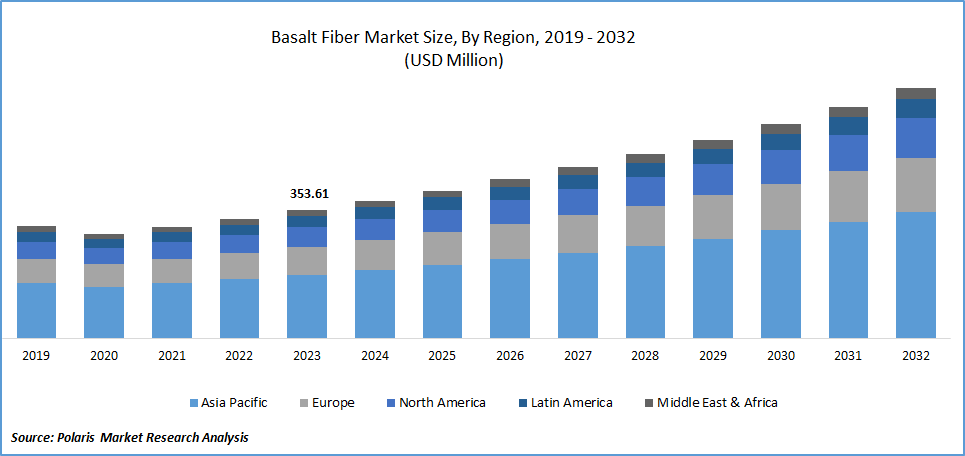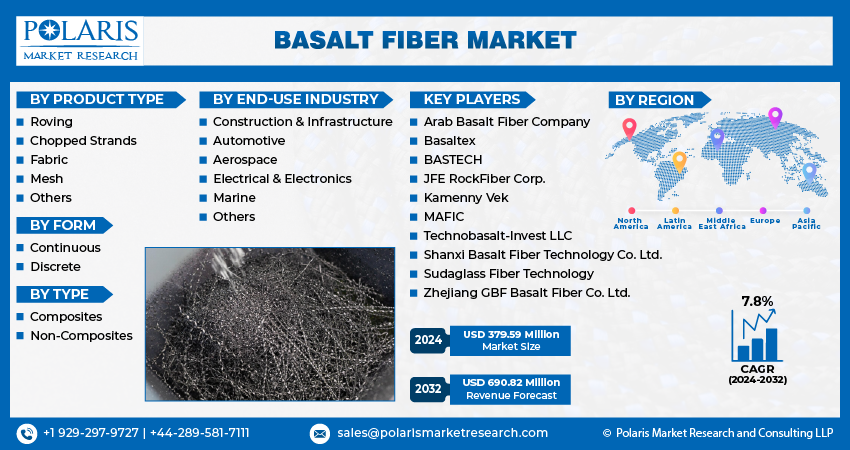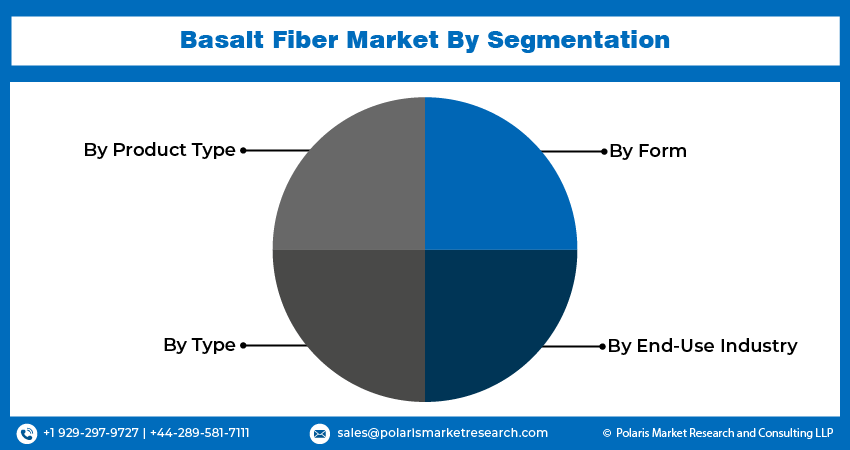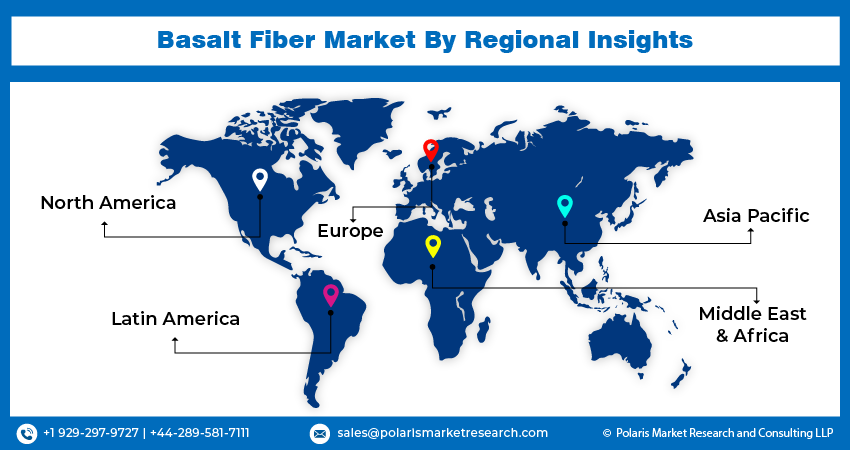
Basalt Fiber Market Share, Size, Trends, Industry Analysis Report, By Product Type; By Form (Continuous and Discrete); By Type; By End-Use Industry; By Region; Segment Forecast, 2024 - 2032
- Published Date:Feb-2024
- Pages: 119
- Format: pdf
- Report ID: PM4356
- Base Year: 2023
- Historical Data: 2019-2022
Report Outlook
The global basalt fiber market was valued at USD 353.61 million in 2023 and is expected to grow at a CAGR of 7.8% during the forecast period.
The growth of the construction industry is one of the primary drivers of the global market analysis. The construction industry is the major contributor to the global economy, accounting for about 13% of the world’s GDP in 2022. The Global Infrastructure Outlook estimates a USD 15 trillion infrastructure investment gap by 2040, which is being addressed by increased spending on projects like roads, bridges, railways, airports, ports, water supply, sanitation, and energy.
Product innovations, technological advancements, and the introduction of regulatory policies have been detailed in the report to enable businesses to make more informed decisions. Furthermore, the impact of the COVID-19 pandemic on the basalt fiber market demand has been examined in the study. The report is a must-read for anyone looking to develop effective strategies and stay ahead of the curve.

To Understand More About this Research; Request a Free Sample Report
Basalt fiber is widely used in the construction industry due to its high strength, durability, and resistance to corrosion. Basalt fiber has high tensile strength, which makes it an ideal material for reinforcing concrete structures. It is also highly durable and can withstand harsh weather conditions, making it suitable for use in construction projects that require long-lasting and reliable materials. Basalt fiber is a cost-effective alternative to traditional construction materials such as steel.
Also, basalt fiber is a sustainable and eco-friendly material that is made from volcanic rock. It does not emit harmful gases or pollutants during production, making it a preferred choice for environmentally conscious construction projects. As governments and private sectors invest heavily in infrastructure projects to bridge the construction industry gap, the demand for basalt fiber is expected to grow significantly in the forecast period.
Growth Drivers
Rising Demand for Basalt Fiber from the Automotive Industry is Driving the Market Growth
One of the major factors driving the global basalt fiber market is the rising demand from the automotive industry. According to Science Direct, the automotive industry accounted for 3.65% of the contribution to global GDP. According to the European Automobile Manufacturer’s Association, in 2022, the global production of motor vehicles reached 85.4 million units, reflecting a 5.7% increase from the previous year, and this production is expected to increase in the next decades. The automotive industry is constantly seeking lightweight materials to reduce vehicle weight, which contributes to improved fuel efficiency and reduces emissions.

Report Segmentation
The market is primarily segmented based on product type, form, type, end-use Industry, and region.
|
By Product Type |
By Form |
By Type |
By End-Use Industry |
By Region |
|
|
|
|
|
To Understand the Scope of this Report; Speak to Analyst
By Product Type Analysis
The Continuous Basalt Fiber (Cbf) Segment Held a Significant Market Share in 2023
The continuous basalt fiber (CBF) segment dominated the global market share in 2023. These types of basalt fibers have higher tensile strength as compared to discrete fibers. CBF has many advantages over other fibers, such as high tensile strength, thermal resistance, durability, and corrosion resistance. CBF is widely used in various industries, such as construction, automotive, aerospace, and marine. In recent years, CFB has gained significant traction in the construction industry due to its advanced mechanical properties, such as high strength and durability. CFB is extensively used in the construction industry for reinforcing concrete, asphalt, and composite materials. Also, the rising demand for manufacturing lightweight and high-performance components for vehicles, such as brake pads, exhaust systems, clutch plates, and engine covers, is driving the segment's growth.
By Form Analysis
The Roving Segment Accounted for the Largest Market Share in 2023
The roving segment dominated the market with the largest market revenue share in 2023. Roving is the most common form of basalt fiber used in various composite applications. It is known for its high tensile strength, resistance to corrosive substances, and thermal stability, making it suitable for reinforcing composites in industries such as automotive, construction, marine, and aerospace. Roving is often used in filament winding, pultrusion, and other composite manufacturing processes to provide strength and reinforcement to the final composite product.
By Type Analysis
Composite Segment Accounted for the Largest Market Share in 2023
In 2023, the composite segment dominated the market with the largest market share. Basalt fiber composites are known for their exceptional mechanical properties, including high strength, stiffness, and resistance to corrosive environments. These properties make them ideal in the various end-use industries, such as automotive, aerospace, and marine industries, which are driving significant demand for basalt fiber composites. Also, basalt fibers are derived from natural volcanic rock, and the manufacturing process involves significantly lower energy consumption and emissions compared to glass or carbon fibers. Thus, rising demand for eco-friendly composite materials propels the growth of this segment.
By End-Use Industry Analysis
The Building & Construction Segment Held a Significant Market Share in 2023
The building & construction segment dominated the market with the largest market share in 2023. The building and construction industry is the biggest user of basalt fiber, which is a material made from the fibers of basalt rock. This is because basalt fiber is strong, lightweight, resistant to corrosion, and provides good insulation against heat and sound. These properties make it useful for reinforcing concrete, making structural composites, and insulating buildings. The demand for basalt fiber is also increasing in the construction industry as it is a natural and non-toxic material that aligns with the trend toward sustainable & eco-friendly construction practices. Basalt fibers are also durable and long-lasting, which reduces maintenance costs for builders and developers.

Regional Insights
Asia Pacific Region Dominated the Global Market Share in 2023
The Asia Pacific region dominated the global basalt fiber market share in 2023. This is primarily due to the rapid growth of the construction industry. Countries such as China, India, Japan, and South Korea are emerging as major construction industry hubs, contributing significantly to the demand for basalt fiber. According to estimates, the investment in the new infrastructure in China during the 5-year Plan period (2021-25) will reach approximately $4.2 trillion. This massive investment will drive the demand for basalt fiber, as it is a preferred material for various infrastructure applications due to its strength, durability, and environmental benefits.
Also, the Korean construction industry is expected to value $166 billion in 2023, down 6.7% from 2022. Despite the decline, the Korean construction industry remains a significant player in the global market. The country's strong manufacturing base and focus on sustainable materials have contributed to its dominance in the market.
North America will grow rapidly due to increasing demand for sustainable and eco-friendly materials across a wide range of industries. In 2022, the total construction spending in the United States accounted for $2,027.1 billion, and Canada's construction spending accounted for $11.5 billion. The significant investments in construction activities in both countries highlight the growing demand for advanced and sustainable materials, such as basalt fiber, in various infrastructure and building projects.

Key Market Players & Competitive Insights
The competitive landscape of the global basalt fiber market is characterized by the presence of numerous key players who have expanded their product portfolio and production capacity to obtain a competitive edge in the market. These companies are continuously adopting marketing strategies such as mergers, acquisitions, capacity expansion, and product innovation to obtain a competitive edge in the market. Several manufacturers in the market are focusing on collaboration with various end-use industries such as aerospace, automotive, sporting goods, and construction.
Some of the major players operating in the global basalt fiber market include:
- Arab Basalt Fiber Company
- Basaltex
- BASTECH
- JFE RockFiber Corp.
- Kamenny Vek
- MAFIC
- Shanxi Basalt Fiber Technology Co. Ltd.
- Sudaglass Fiber Technology
- Technobasalt-Invest LLC
- Zhejiang GBF Basalt Fiber Co. Ltd.
Recent Developments
- In November 2021, Kamenny Vek, a global manufacturer of advanced basalt fibers, opened a new manufacturing plant in Kimry.
- In January 2022, Basaltex, a major Belgium-based basalt fiber products producer, introduced a new line of fiber fabrics tailored for the aerospace and automotive industries.
Basalt Fiber Market Report Scope
|
Report Attributes |
Details |
|
Market size value in 2024 |
USD 379.59 million |
|
Revenue Forecast in 2032 |
USD 690.82 million |
|
CAGR |
7.8% from 2024 – 2032 |
|
Base year |
2023 |
|
Historical data |
2019 – 2022 |
|
Forecast period |
2024 – 2032 |
|
Quantitative units |
Revenue in USD million and CAGR from 2024 to 2032 |
|
Segments Covered |
By Product Type, By Form, By Type, By End-Use Industry, By Region |
|
Regional scope |
North America, Europe, Asia Pacific, Latin America, Middle East & Africa |
|
Key Companies |
MAFIC, Kamenny Vek, Sudaglass Fiber Technology, BASTECH, Technobasalt-Invest LLC, Zhejiang GBF Basalt Fiber Co. Ltd., JFE RockFiber Corp., Shanxi Basalt Fiber Technology Co. Ltd., and Arab Basalt Fiber Company |
|
Customization |
Report customization as per your requirements with respect to countries, regions, and segmentation. |
We strive to offer our clients the finest in market research with the most reliable and accurate research findings. We use industry-standard methodologies to offer a comprehensive and authentic analysis of the basalt fiber market. Besides, we have stringent data-quality checks in place to enable data-driven decision-making for you.
FAQ's
The global Basalt Fiber Market size is expected to reach USD 690.82 million by 2032
MAFIC Kamenny Vek, BASTECH, JFE RockFiber Corp., Shanxi Basalt Fiber Technology, and Arab Basalt Fiber Company are the top market players in the market.
Asia Pacific region contribute notably towards the global Basalt Fiber Market.
The global basalt fiber market is expected to grow at a CAGR of 7.8% during the forecast period.
The Basalt Fiber Market report covering key segments are Product Type, Form, Type, End-Use Industry, and Region.
